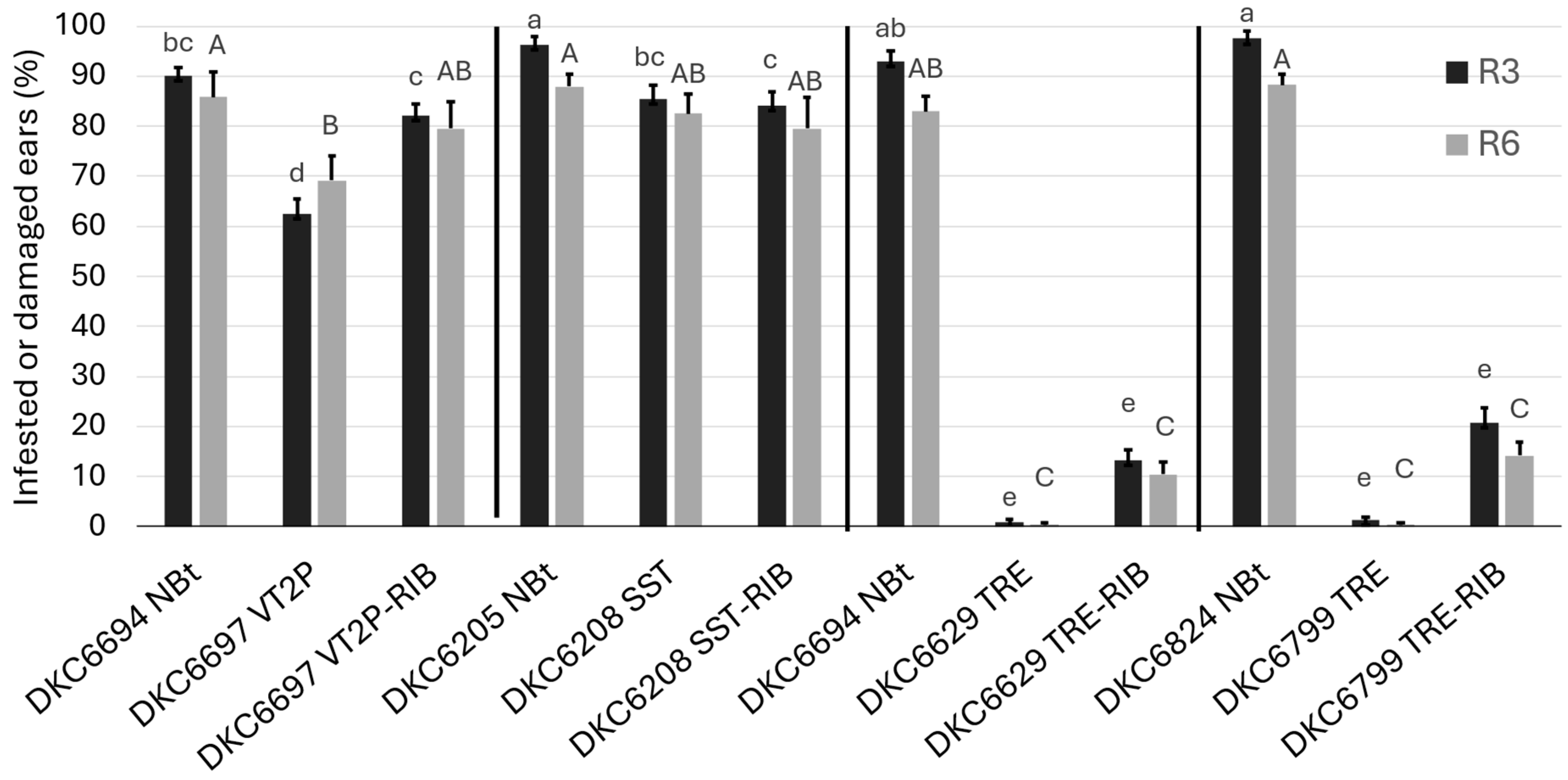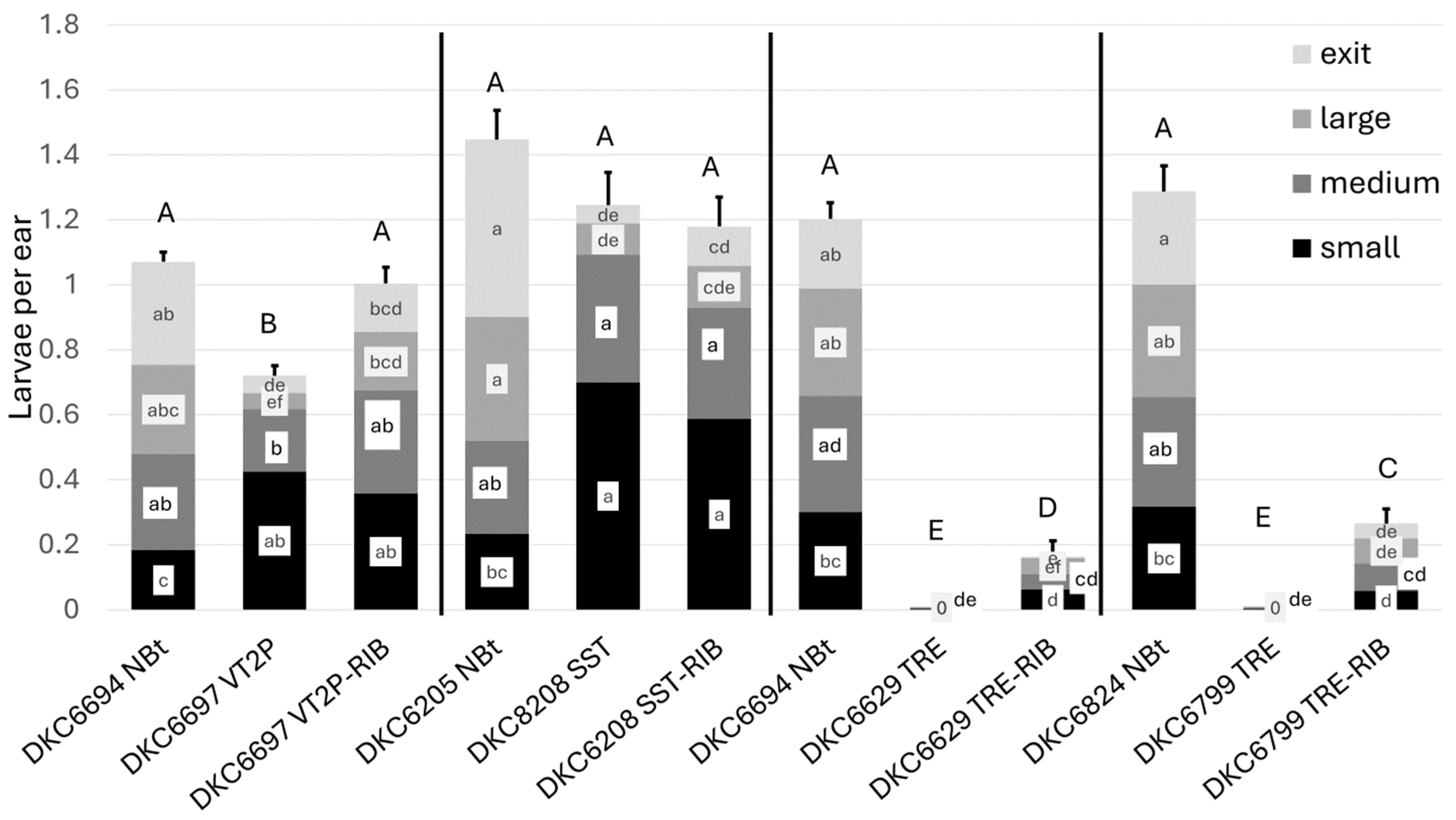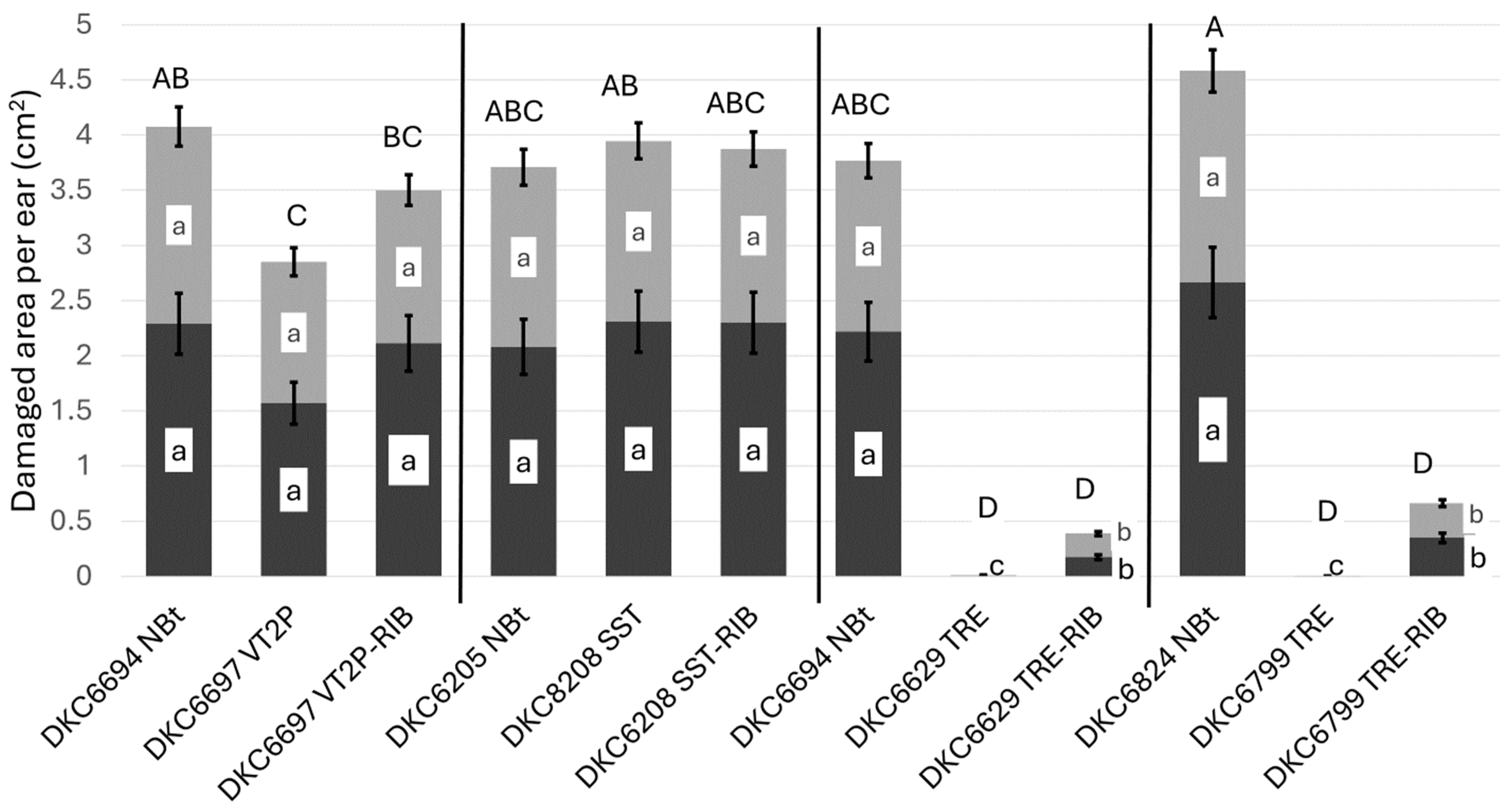Effect of Blended Bt Corn Refuge on Corn Earworm (Lepidoptera: Noctuidae) Infestation and Grain Yield
Abstract
:1. Introduction
2. Materials and Methods
2.1. Field Experiments
2.2. Data Collection
2.3. Statistical Analyses
3. Results
3.1. Results of Experiment 1
3.2. Results of Experiment 2
4. Discussion
5. Conclusions
Supplementary Materials
Author Contributions
Funding
Data Availability Statement
Acknowledgments
Conflicts of Interest
References
- Ostlie, K.R.; Hutchison, W.D.; Hellmich, R.L. Bt Corn and European Corn Borer; North Central Regional Publication 602; University of Minnesota: St. Paul, MN, USA, 1997; p. 38. [Google Scholar]
- Tabashnik, B.E.; Fabrick, J.A.; Carriere, Y. Global patterns of insect resistance to transgenic Bt crops: The first 25 years. J. Econ. Entomol. 2023, 116, 297–309. [Google Scholar] [CrossRef] [PubMed]
- Buntin, G.D.; Lee, R.D.; Wilson, D.M.; McPherson, R.M. Evaluation of YieldGard transgenic resistance for control of fall armyworm and corn earworm (Lepidoptera: Noctuidae) on corn. Fla. Entomol. 2001, 84, 37–42. [Google Scholar] [CrossRef]
- Buntin, G.D.; All, J.N.; Lee, R.D.; Wilson, D.M. Plant-incorporated Bacillus thuringiensis resistance for control of fall armyworm and corn earworm (Lepidoptera: Noctuidae) in corn. J. Econ. Entomol. 2004, 97, 1603–1611. [Google Scholar] [CrossRef] [PubMed]
- Buntin, G.D. Corn expressing Cry1Ab or Cry1F endotoxin for fall armyworm and corn earworm (Lepidoptera: Noctuidae) management in field corn for grain production. Fla. Entomol. 2008, 91, 523–530. [Google Scholar]
- Reay-Jones, F.P.F.; Reisig, D.D. Impact of corn earworm injury on yield of transgenic corn producing Bt toxins in the Carolinas. J. Econ. Entomol. 2014, 107, 1101–1109. [Google Scholar] [CrossRef]
- DiFonzo, C.; The Handy Bt Trait Table for U.S. Corn Production. 2024. Available online: https://www.texasinsects.org/bt-corn-trait-table.html (accessed on 30 March 2024).
- U.S. Department of Agriculture, Economic Research Service. Recent Trends in GE Adoption. Available online: https://www.ers.usda.gov/data-products/adoption-of-genetically-engineered-crops-in-the-u-s/recent-trends-in-ge-adoption (accessed on 13 May 2024).
- Onstad, D.W.; Crespo, A.L.B.; Pan, Z.; Crain, P.R.; Thompson, S.D.; Pilcher, C.D.; Sethi, A. Blended refuge and insect resistance management for insecticidal control. Environ. Entomol. 2018, 47, 210–219. [Google Scholar] [CrossRef]
- Storer, N.P.; van Duyn, J.W.; Kennedy, G.G. Life history traits of Helicoverpa zea (Lepidoptera: Noctuidae) on non-Bt and Bt transgenic corn hybrids in eastern North Carolina. J. Econ. Entomol. 2001, 62, 82–87. [Google Scholar] [CrossRef]
- U.S. Environmental Protection Agency. Insect Resistance Management for Bt Plant-Incorporated Protectants. Available online: https://www.epa.gov/regulation-biotechnology-under-tsca-and-fifra/insect-resistance-management-bt-plant-incorporated (accessed on 13 May 2024).
- Head, G.P.; Greenplate, J. The design and implementation of inset resistance management program for Bt crops. GM Crops Food 2012, 3, 144–153. [Google Scholar] [CrossRef]
- Carroll, M.W.; Head, G.P.; Caprio, M. When and where a seed mix refuge makes sense for managing insect resistance in Bt. Plants. Crop. Protect. 2012, 38, 74–79. [Google Scholar] [CrossRef]
- Dively, G.P.; Venugopal, P.D.; Finkenbinder, C. Field-evolved resistance in corn earworm to Cry proteins expressed in transgenic sweet corn. PLoS ONE 2016, 11, e0169115. [Google Scholar] [CrossRef]
- Bilbo, T.R.; Reay-Jones, P.F.; Reisig, D.D.; Greene, J.K. Susceptibility of corn earworm (Lepidoptera: Noctuidae) to Cry1A.105 and Cry3Ab2 in North and South Carolina. J. Econ. Entomol. 2019, 112, 1845–1857. [Google Scholar] [CrossRef] [PubMed]
- Yu, W.; Lin, S.; Dimase, M.; Niu, Y.; Brown, S.; Head, G.P.; Price, P.A.; Reay-Jones, F.P.F.; Cook, D.; Reisig, D.; et al. Extended investigation of field-evolved resistance of corn earworm Helicoverpa zea (Lepidoptera: Noctuidae) to Bacillus thuringiensis Cry1A.105 and Cry2Ab2 proteins in southeastern United. States. J. Invertebr. Pathol. 2021, 183, 107560. [Google Scholar] [CrossRef] [PubMed]
- Reay-Jones, F.P.F.; Buntin, G.D.; Reisig, D.D.; Bridges, W.C., Jr. Longitudinal trails illustrate interactive effects between declining Bt Efficacy against Helicoverpa zea and planting dates in corn. J. Econ. Entomol. 2024, toae160. [Google Scholar] [CrossRef] [PubMed]
- Yang, F.; Kerns, D.L.; Little, N.S.; Santiago Gonzalez, J.C.; Tabashnik, B.E. Early warning of resistance to Bt toxin Vip3Aa in Helicoverpa zea. Toxins 2021, 13, 618. [Google Scholar] [CrossRef] [PubMed]
- Yang, F.; Kerns, D.L.; Little, N.S.; Brown, S.A.; Stewart, S.D.; Catchot, A.L.; Cook, D.R.; Gore, J.; Crow, W.D.; Lorenz, G.M.; et al. Practical resistance to cry toxins and efficacy of Vip3Aa to Bt cotton against Helicoverpa zea. Pest Manag. Sci. 2022, 78, 5234–5242. [Google Scholar] [CrossRef]
- Jaffe, G. Complacency of the Farm: Significant Non-Compliance with EPA’s Refuge Compliance Threatens the Future Effectiveness of Genetically Engineered Pest Protected Corn. Center for Science in the Public Interest. November 9 Report. 2009. Available online: https://www.cspinet.org/sites/default/files/attachment/complacencyonthefarm.pdf (accessed on 2 April 2024).
- Que, Q.; Chilton, M.D.; de Fontes, C.M.; He, C.; Nuccio, M.; Zhu, T.; Wu, Y.; Chen, S.H.; Shi, L. Trait stacking in transgenic crops: Challenges and opportunities. GM Crops 2010, 1, 220–229. [Google Scholar] [CrossRef]
- Towles, T.B.; Buntin, G.D.; Catchot, A.L.; Gore, J.; Cook, D.R.; Caprio, M.A.; Daves, C. Quantifying the contribution of seed blended refugia in field corn to Helicoverpa zea (Lepidoptera: Noctuidae) populations. J. Econ. Entomol. 2021, 114, 1771–1778. [Google Scholar] [CrossRef]
- Mallet, J.; Porter, P. Preventing insect adaptation to insect-resistant crops: Are seed mixtures or refugia the best strategy? Proc. R. Soc. B 1992, 250, 165–169. [Google Scholar]
- Burkness, E.C.; Hutchison, W.D. Bt pollen dispersal and Bt kernel mosaics: Integrity of non-Bt refugia for lepidopteran resistance management in maize. J. Econ. Entomol. 2012, 105, 1773–1780. [Google Scholar] [CrossRef]
- Yang, F.; Kerns, D.L.; Head, G.P.; Leonard, B.R.; Levy, R.; Nui, Y.; Huang, F. A challenge for the seed mixture refuge strategy in Bt maize: Impact of cross-pollination on an ear-feeding insect. PLoS ONE 2014, 9, e112962. [Google Scholar] [CrossRef]
- Caprio, M.A.; Martinez, J.C.; Porter, P.A.; Bynum, E. The impact of inter-kernel movement in the evolution of resistance to dual-toxin Bt corn varieties in Helicoverpa zea (Lepidoptera: Noctuidae). J. Econ. Entomol. 2016, 109, 307–319. [Google Scholar] [CrossRef] [PubMed]
- Hardwick, D.F. The corn earworm complex. Mem. Entomol. Soc. Can. 1965, 40, 1–247. [Google Scholar] [CrossRef]
- Wiseman, B.R. Corn earworm. In Handbook of Corn Insects; Steffey, K.L., Rice, M.E., All, J., Andow, D.A., Gray, M.E., van Duyn, J., Eds.; Entomological Society of America: Lanham, MD, USA, 1999; pp. 59–61. [Google Scholar]
- Bowen, K.L.; Flanders, K.L.; Hagan, A.K.; Ortiz, B. Insect damage, aflatoxin content, and yield of Bt corn in Alabama. J. Econ. Entomol. 2014, 107, 1818–1827. [Google Scholar] [CrossRef]
- Bibb, J.L.; Cook, D.; Catchot, A.; Musser, F.; Stewart, S.B.; Leonard, B.R.; Buntin, G.D.; Kerns, D.; Allens, T.W.; Gore, J. Impact of corn earworm (Lepidoptera; Noctuidae) on field corn (Poales: Poaceae) yield and grain quality. J. Econ. Entomol. 2018, 111, 1249–1255. [Google Scholar] [CrossRef]
- Olivi, B.M.; Gore, J.; Musser, F.M.; Catchot, A.L.; Cook, D.R. Impact of simulated corn earworm (Lepidoptera: Noctuidae) kernel feeding on field corn yield. J. Econ. Entomol. 2019, 122, 2193–2198. [Google Scholar] [CrossRef]
- Reay-Jones, F.P. Pest status and management of corn earworm (Lepidoptera: Noctuidae) in field corn in the United States. J. Integr. Pest Manag. 2019, 10, 19. [Google Scholar] [CrossRef]
- Bruns, H.A.; Abbas, H.K. Planting date effects on Bt and non-Bt corn in the mid-South USA. Agron. J. 2006, 98, 100–106. [Google Scholar] [CrossRef]
- Brewer, M.J.; Odvody, G.N.; Anderson, D.J.; Remmers, J.C. A comparison of Bt transgene, hybrid, background, water stress, and insect stress effects on corn leaf and ear injury and subsequent yield. Environ. Entomol. 2014, 43, 828–839. [Google Scholar] [CrossRef]
- Reisig, D.D.; Akin, D.S.; All, J.N.; Bessin, R.T.; Brewer, M.J.; Buntin, G.D.; Catchot, A.L.; Cook, D.; Flanders, K.L.; Haung, F.N.; et al. Lepidoptera (Crambidae, Noctuidae, and Pyralidae) injury to corn containing single and pyramided Bt traits, and blended or block refuge, in the southern United States. J. Econ. Entomol. 2015, 108, 157–165. [Google Scholar] [CrossRef] [PubMed]
- Reay-Jones, F.P.F.; Bessin, R.T.; Brewer, M.J.; Buntin, G.D.; Catchot, A.L.; Cook, D.R.; Flanders, K.L.; Kerns, D.L.; Porter, R.P.; Reisig, D.D.; et al. Impact of Lepidoptera (Crambidae, Noctuidae, and Pyralidae) pests on corn containing pyramided Bt traits and a blended refuge in the southern United States. J. Econ. Entomol. 2016, 109, 1859–1871. [Google Scholar] [CrossRef]
- Davis, F.M.; Ng, S.S.; Williams, W.P. Visual rating scales for screening whorl-stage corn for resistance to fall armyworm. Miss. Agric. Fores. Exper. Stn. Bull. 1992, 186, 1–9. [Google Scholar]
- SAS Institute. SAS Version 9.4 User’s Manual; SAS Institute: Cary, NC, USA, 2013. [Google Scholar]
- Bilbo, T.R.; Reay-Jones, F.P.; Reisig, D.D.; Musser, F.R.; Greene, J.K. Effects of Bt corn on the development and fecundity of corn earworm (Lepidoptera: Noctuidae). J. Econ. Entomol. 2018, 111, 2233–2241. [Google Scholar] [CrossRef]
- Gould, F. Sustainability of transgenic insecticidal cultivars; integrating pest genetics and ecology. Annu. Rev. Entomol. 1998, 43, 701–726. [Google Scholar] [CrossRef]
- Onstad, D.W.; Mitchell, P.D.; Hurley, T.M.; Lundgren, J.G.; Porter, R.P.; Krupke, C.H.; Spencer, J.L.; DiFonzo, C.D.; Baute, T.S.; Helmich, R.L.; et al. Seeds of change: Corn seed mixtures for resistance management and Integrated Pest Management. J. Econ. Entomol. 2011, 104, 343–352. [Google Scholar] [CrossRef]
- Reisig, D.D. Factors associated with willingness to plant non-Bt maize refuge and suggestions for increasing refuge compliance. J. Integr. Pest Manag. 2017, 8, 1–10. [Google Scholar] [CrossRef]
- Burkness, E.C.; O’Rourke, P.K.; Hutchinson, W.D. Cross-pollination of nontransgenic corn ears with transgenic Bt corn: Efficacy against lepidopteran pest and implications for resistance management. J. Econ. Entomol. 2011, 104, 1476–1479. [Google Scholar] [CrossRef]
- Steckel, S.; Stewart, S.D. Intraear compensation of field corn, Zea mays, from simulated and naturally occurring injury by ear-feeding larvae. J. Econ. Entomol. 2015, 108, 1106–1114. [Google Scholar] [CrossRef]
- Reisig, D.D.; Heiniger, R. Yield analysis of corn earworm, Helicoverpa zea (Lepidoptera: Noctuidae) feeding in Bt and non-Bt hybrids across diverse locations. J. Econ. Entomol. 2024, 117, 1503–1509. [Google Scholar] [CrossRef]




| Hybrid Name | Bt Treatment a | Bt Toxins | Grain Yield (kg ha−1) | Grain Test Weight (kg hL−1) |
|---|---|---|---|---|
| DKC 6694 | None | None | 13,666 ± 363 a | 74.0 ± 2.0 a |
| DKC 6697 | VT Double PRO | Cry1A.105 + Cry2Ab2 | 13,978 ± 495 a | 74.0 ± 1.6 a |
| DKC 6697/6694 | VT Double PRO—20%RIB | Cry1A.105 + Cry2Ab2 | 14,595 ± 711 a | 73.0 ± 1.9 a |
| DKC 6205 | None | None | 14,167 ± 548 a | 72.9 ± 1.5 a |
| DKC 6208 | SmartStax | Cry1A.105 + Cry2Ab2 + Cry1Fa2 | 13,584 ± 763 a | 73.9 ± 0.9 a |
| DKC 6205/6208 | SmartStax—20%RIB | Cry1A.105 + Cry2Ab2 + Cry1Fa2 | 13,662 ± 458 a | 73.7 ± 1.1 a |
| DKC 6694 | None | None | 14,174 ± 925 a | 73.9 ± 1.9 a |
| DKC 6629 | Trecepta1 | Cry1A.105 + Cry2Ab2 + Vip3Aa20 | 14,934 ± 729 a | 75.4 ± 1.7 a |
| DKC 6629/6694 | Trecepta1—20%RIB | Cry1A.105 + Cry2Ab2 + Vip3Aa20 | 14,380 ± 596 a | 74.2 ± 1.2 a |
| DKC 6824 | None | None | 14,521 ± 672 a | 73.1 ± 1.4 a |
| DKC 6799 | Trecepta2 | Cry1A.105 + Cry2Ab2 + Vip3Aa20 | 14,279 ± 639 a | 71.8 ± 1.2 a |
| DKC6799/6824 | Trecepta2—20%RIB | Cry1A.105 + Cry2Ab2 + Vip3Aa20 | 13,860 ± 907 a | 73.4 ± 1.3 a |
| Bt Treatment a | Bt Toxins | Infested Ears at R3 (%) | Damaged Ears at R6 (%) | Damaged Kernels per Ear (cm2) | Grain Yield (kg ha−1) | Grain Test Weight (kg hL−1) |
|---|---|---|---|---|---|---|
| Non-Bt | None | 87.50 ± 4.77 a | 75.63 ± 7.89 a | 5.60 ± 0.98 a | 11,554 ± 268 c | 71.9 ± 0.5 a |
| Genuity VTDouble PRO | Cry1A.105 + Cry2Ab2 | 69.38 ± 7.37 b | 60.63 ± 8.32 b | 4.09 ± 0.79 a | 11,822 ± 289 bc | 73.4 ± 0.8 a |
| Genuity Trecepta 0% Blend | Cry1A.105 + Cry2Ab2 + Vip3Aa20 | 0.31 ± 0.31 e | 0.31 ± 0.31 d | 0 d | 12,352 ± 370 ab | 72.4 ± 0.7 a |
| Genuity Trecepta—10% Blend | Cry1A.105 + Cry2Ab2 + Vip3Aa20 | 9.06 ± 1.53 de | 5.94 ± 1.23 d | 0.21 ± 0.07 c | 12,522 ± 257 a | 72.8 ± 0.8 a |
| Genuity Trecepta—20% Blend | Cry1A.105 + Cry2Ab2 + Vip3Aa20 | 16.88 ± 2.77 cd | 11.56 ± 2.64 cd | 0.53 ± 0.14 bc | 12,245 ± 332 abc | 72.8 ± 0.8 a |
| Genuity Trecepta—30% Blend | Cry1A.105 + Cry2Ab2 + Vip3Aa20 | 24.69 ± 2.87 c | 17.81 ± 2.85 c | 0.78 ± 0.20 b | 12,237 ± 267 abc | 71.8 ± 0.8 a |
Disclaimer/Publisher’s Note: The statements, opinions and data contained in all publications are solely those of the individual author(s) and contributor(s) and not of MDPI and/or the editor(s). MDPI and/or the editor(s) disclaim responsibility for any injury to people or property resulting from any ideas, methods, instructions or products referred to in the content. |
© 2024 by the authors. Licensee MDPI, Basel, Switzerland. This article is an open access article distributed under the terms and conditions of the Creative Commons Attribution (CC BY) license (https://creativecommons.org/licenses/by/4.0/).
Share and Cite
Buntin, G.D.; Rowe, P.S. Effect of Blended Bt Corn Refuge on Corn Earworm (Lepidoptera: Noctuidae) Infestation and Grain Yield. Agronomy 2024, 14, 2246. https://doi.org/10.3390/agronomy14102246
Buntin GD, Rowe PS. Effect of Blended Bt Corn Refuge on Corn Earworm (Lepidoptera: Noctuidae) Infestation and Grain Yield. Agronomy. 2024; 14(10):2246. https://doi.org/10.3390/agronomy14102246
Chicago/Turabian StyleBuntin, George David, and Pamella Somerville Rowe. 2024. "Effect of Blended Bt Corn Refuge on Corn Earworm (Lepidoptera: Noctuidae) Infestation and Grain Yield" Agronomy 14, no. 10: 2246. https://doi.org/10.3390/agronomy14102246





